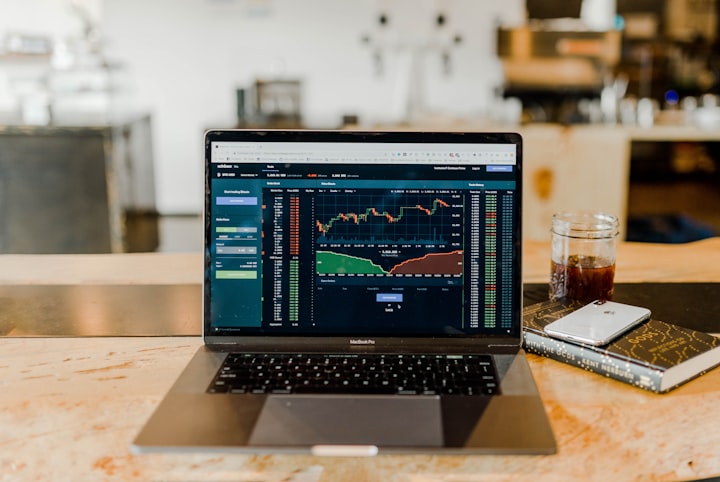5 Big Trends of Commodity Trading
Trends and highlights of commodity market for successful trading.

Commodity trading has witnessed a historic surge in recent years, with 2022 marking a pivotal turning point for the industry. In this article, we'll delve into the key trends and factors that contributed to this surge and explore how to trade commodities in Canada. As the industry continues to evolve, it's essential for traders, both seasoned and newcomers, to stay informed and adapt to the changing landscape.

Commodity Trading's Most Profitable Year
The year 2022 witnessed an unprecedented milestone in the commodity trading industry, with the gross margin surpassing $100 billion. This remarkable achievement was the culmination of a steady upward trajectory, with industry revenue nearly tripling since 2018 when it stood at $36 billion. This remarkable growth far exceeded the $57 billion in gross margins in 2009, following the global financial crisis. (See exhibit for a visual representation of total global commodity trading gross margin.)
Industry Status Update
The value pools in commodity trading have witnessed substantial growth, nearly doubling from $27 billion in 2018 to an estimated $52 billion of EBIT in 2021 (Exhibit 1). This expansion was largely driven by EBIT from oil trading, which surged by more than 90 percent to reach $18 billion during this period. Power and gas trading followed closely, rising from $7 billion to $13 billion. These value pools maintained their upward trajectory in 2022, and the market is expected to attract new entrants, intensifying competition and fueling further growth.
Market Factors Driving Trading Opportunities
The phenomenal expansion of the industry was underpinned by several key market factors that created opportunities for traders:
1. Dramatic Volatility: Commodities markets in 2022 exhibited extreme volatility, offering traders the chance to profit from both upward and downward price movements. This extraordinary level of volatility made commodities trading an attractive prospect for those with the right strategies in place.
2. Trade Flow Changes: The energy sector, in particular, experienced significant shifts in shipping patterns. Traders capable of adapting to these changes, re-routing cargo, and identifying new sources and outlets gained a significant advantage in the market.
3. Stable Demand Growth and Short Markets: Despite the ongoing recovery from the COVID-19 pandemic, demand for commodities and energy remained robust throughout the year. The combination of high demand and tight, potentially unavailable supplies pushed prices and volatility to new heights.
4. Significant Increase in Collateral Requirements: The demand for cash collateral increased substantially in 2022, leading some traders to abandon in-the-money positions due to liquidity constraints. This added pressure prompted players to assess their financial situations and strive for capital-efficient returns.
In light of these market dynamics, 2022 emerged as a significant year for traders across all sectors. However, certain characteristics and traits set successful commodity traders apart.
Characteristics of Successful Commodity Traders
While factors like size and access to capital are crucial for traders, three additional character traits became performance accelerators, propelling traders beyond expectations:
- Culture of Agility: Traders who embraced a culture of agility, adaptability, and constant evolution thrived in the ever-changing commodity market. The ability to pivot quickly in response to market shifts and emerging trends proved invaluable.
- Constant Evolution: Commodity trading is an evolving landscape, and traders who remained at the forefront of industry developments fared exceptionally well. Staying informed about technological advancements, market innovations, and regulatory changes was vital.
- Bravery: Courage and risk-taking are inherent in the world of commodities trading. Traders who were unafraid to take calculated risks and explore new avenues reaped the rewards of their bold decisions.
As the commodity trading industry continues to transform, staying abreast of these character traits and adopting them as part of one's trading strategy will be instrumental in achieving success.
Commodity trading, a cornerstone of global economic exchange, is undergoing a profound transformation. The energy transition, a radical shift that spans the realms of food, energy, and materials, is altering the very fabric of the industry. This transformation heralds an era of heightened structural volatility, the reconfiguration of trade flows, the redefinition of commodities, and a fundamental reordering of commercial relationships. This shift brings forth unique opportunities and challenges for both new entrants and established players.
Five Key Success Factors for the Future
To seize opportunities in the evolving commodity trading landscape, traders must invest in new capabilities. Five factors have emerged as crucial to success in the years ahead:
1. Customer-Centricity in the Energy Transition
The energy transition is reshaping commodities, with new offerings differentiated by geography, production methods, regulations, and environmental impact. Customer centricity is crucial as it allows traders to anticipate customer needs, tailor high-quality products, understand value chain bottlenecks, and shape customer behavior strategically.
2. Embrace Short-Term Markets
The perception of risk has changed, with many customers favoring Long-Term Contracts (LTCs). However, producers will need to maintain flexibility, especially for new commodities. A shift to short-term markets is expected, providing arbitrage opportunities and flexibility.
3. Invest in Decarbonization as an Asset Class
Green products are in demand, and players who understand the green premium can unlock arbitrage opportunities. Understanding evolving carbon markets and tracking carbon exposure is essential. First-movers may benefit from price differentials and technological advancements.
4. Rapidly Ramp Up Trading Capabilities
Growing value pools and lower barriers to entry may lead to increased competition. Scale is critical for better risk-adjusted returns, global access, and competitive financing. The pursuit of "smart scale" involves focusing on alternative positions and products.
5. Balance Efficiency and Agility
Trading platforms and operating models need to balance efficiency and agility to facilitate growth, especially in light of talent shortages and increased data use in trading analytics. Investments should align with strategic goals.
Three Potential Business Models
As the industry undergoes transformation, three potential business models could emerge:
1. The Global Smart-Scale Trader: This model capitalizes on digital enablement, automation, and short-term markets. Players pursue thinner margins, achieve global reach, and explore organic and inorganic growth to maintain their competitive edge. Incumbents may acquire smaller players and shift from capital expenditure-based models to operating expenditure-based ones.
2. The Niche Trader Mastering 'Complexity': In markets where scale is less relevant, niche traders with specialized expertise and technology capabilities will thrive. They may focus on regional or commodity-specific niches, serving as acquisition targets for larger players looking to expand their scale and capabilities.
3. The Tactical Trader-Investor: These players capitalize on supply and demand imbalances by taking positions that solve these imbalances. They possess a private equity mindset, use their balance sheets to take equity in illiquid physical positions, and appreciate the value of optionality.
The evolving landscape of commodity trading presents immense opportunities and uncertainties. The winners in this dynamic environment will be those who invest in the five success factors and demonstrate the agility to adapt swiftly to industry shifts.
The next normal in commodity trading is upon us, and it is calling for new types of traders with fresh strategies and capabilities to navigate this evolving landscape.
Conclusion
The year 2023 marked a watershed moment in the world of commodities trading, with record-breaking gross margins and unprecedented growth in various sectors. The key commodities driving this boom were oil and natural gas, underpinned by dramatic market factors and increased demand. While size and capital access are vital, traders who embrace agility, continuous evolution, and courage have a competitive edge.
For those interested in commodities trading in Canada, these trends underscore the importance of staying informed, developing a robust trading strategy, and being prepared to adapt to the ever-evolving landscape. The commodity trading industry's growth presents ample opportunities for traders who are willing to seize them, and Canada is no exception to this global trend.
About the Creator
Ara Zohrabian
Ara Zohrabian, an author and an expert in fundamental and technical analysis. Currently he is a Senior Analytical Expert at IFCMarkets Corp.
Enjoyed the story? Support the Creator.
Subscribe for free to receive all their stories in your feed. You could also pledge your support or give them a one-off tip, letting them know you appreciate their work.






Comments
There are no comments for this story
Be the first to respond and start the conversation.